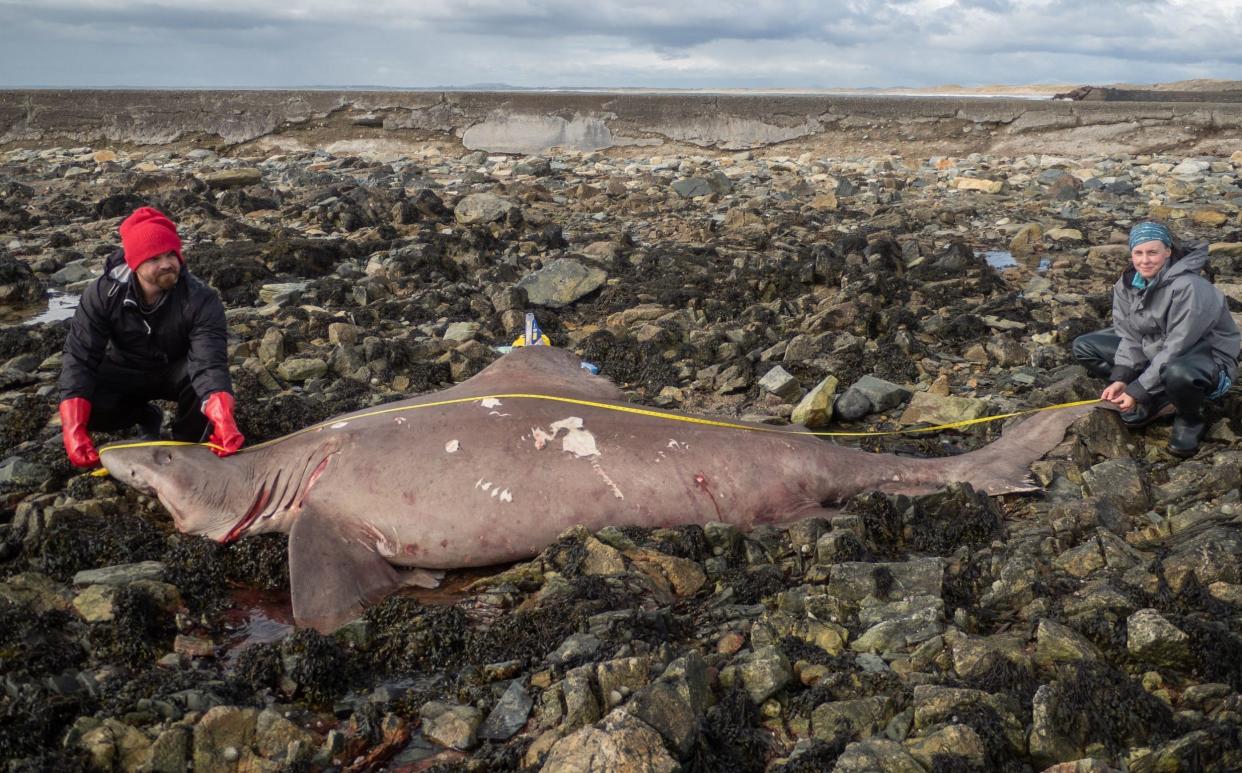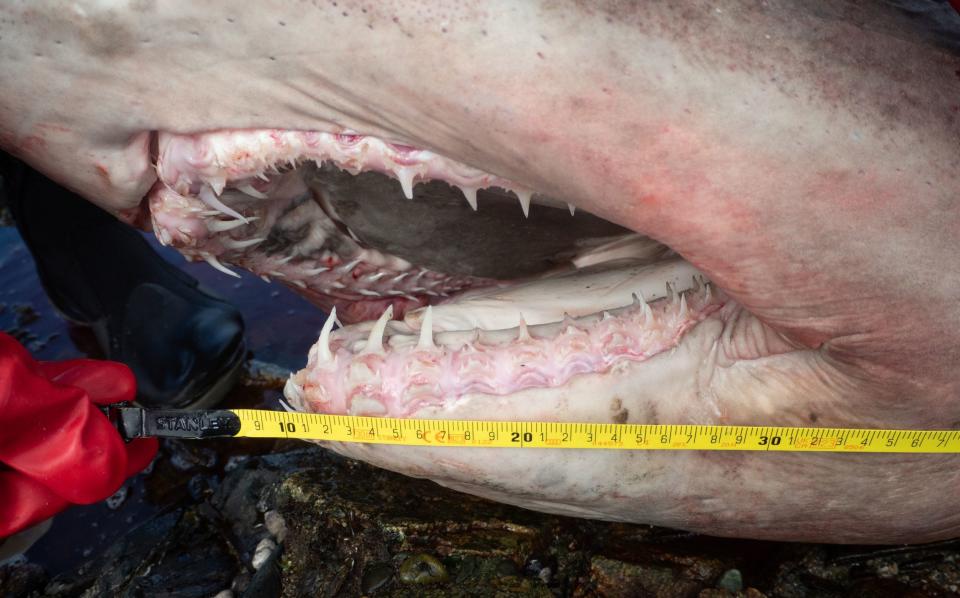Latest washed-up shark could unlock the answer to earlier beach mystery

A second rare shark has been found stranded on a beach and suggests the species could be making British waters its home, scientists believe.
The large female smalltooth tiger shark was discovered at a beach in Wexford, Ireland at the weekend and is the same species as the shark which was found in Hampshire last month and beheaded by scavengers.
Experts hope that by studying the remains of the Wexford shark they can finally solve the mystery of what killed the decapitated and mutilated case in England.
Smalltooth tiger sharks have never before been found in British waters and two strandings so close together geographically and temporally have raised suspicions.
Irish and British teams of scientists are now working together, pooling data and resources, to determine what killed the sharks, why they were in British waters, and if they are here to stay.
The species is traditionally thought to prefer warm and deep waters, making the British and Irish coastlines unlikely stranding spots. The smalltooth tiger shark is classified as vulnerable and poses no threat to humans.
Dr David Curnick, Head of the Ocean Predator Lab at ZSL, is working with the Ireland team to study the co-occurrence of the two shark stranding.
"However, a second individual in quick succession seems more than a coincidence and suggests that these sharks, which are more commonly found in deeper water, may be using UK and Irish waters more readily than we previously thought,” he told The Telegraph.
"Coupling these two new occurrences, which are the most northerly records for the species, with the flurry of recent reports of the species elsewhere, suggest that they may be expanding their range northwards and into more temperate waters.
"Over the coming weeks and months, we will be working closely with our colleagues in Ireland to understand what might be driving these shifts and, hopefully, work out what caused the death of both animals."
Scientists were alerted to the latest stranding by two Swiss tourists on holiday in the remote fishing village of Kilmore Quay on the south coast of Ireland.
This shark, a 15ft long adult female, died only a couple of days before experts found her carcass on Saturday lunchtime. The carcass was in good condition and completely intact.
She is roughly the size of a family saloon car and twice as big as the Lepe Beach case.
British scientists had been hoping to study the Lepe shark to find out how it died and learn more about the species itself as the smalltooth tiger is understudied.
However, the experts were thwarted by thieves who stole not only the entire head, but also fins and organs, robbing the team of the ability to find a cause of death.
Connection between two strandings
Now, the scientific community is hopeful the Wexford case can help solve the missed opportunity of the headless Lepe case.
Rob Deaville, head of the DEFRA-funded cetacean strandings investigation programme (CSIP) at the ZSL, is in charge of large shark, whale and dolphin strandings in England and Wales.
“It is like trying to do a jigsaw puzzle with half the pieces missing, you never get a full picture," he said.
But now, Dr Nicholas Payne, an assistant professor in Trinity College Dublin's School of Natural Sciences, is hoping to find answers to the Wexford case, and will see if there is a connection between the two strandings.
He was tipped off about the new shark at midnight on Friday after the Swiss tourists Googled "shark biology experts Ireland" and found his contact tails.
The attached photos and comments led Dr Payne to cancel his Saturday plans and drive two hours down the coast in a van the next morning to pick up the shark.

“We were very conscious of what happened over in the UK a few weeks ago so myself and a couple of my team just scrambled rapidly on Saturday morning, got everything ready and then drove straight down because we were a little bit concerned about losing the carcass to either nature or, to a lesser extent, scavengers,” Dr Payne told The Telegraph.
“By the time we got down there it was still in really good condition and we were able to take everything that we wanted from the animal.
“We knew this kind of opportunity could not be missed and we just cancelled our Saturday plans and headed down there.”
However, upon arrival the team realised the tourist’s estimate of the shark being two metres long turned out to be inaccurate as the Wexford case was actually more than four metres long, making it twice as long as the Lepe individual.
“As soon as we got to the shore we saw it was massive. It was well, well over four metres,” Dr Payne said.
“It was a really, really big animal. And what that meant is we had difficulty even manoeuvring it to sample the things that we wanted, let alone bring the whole thing back.”
One of the key priorities for the team was to ensure they had the whole head as the decapitation of the Lepe case meant scientists were unable to learn more about how the animal died and also more about the species.
‘Samples of the brain’
“We dissected the whole head from approximately the gills and we took it back because there's so much in there that we want to learn about,” Dr Payne told the Telegraph.
“We want to take samples of the brain to look at potential infections and toxicology and we want to look at the teeth, we want to look at the eyes, the gill structure and more.
“That was one part of the animal that we could logistically handle taking back with us. Both eyes were still intact, which was great as they're normally one of the first things to go.”
The team will try and find out what the Wexford shark died of, if it was genetically related to the Lepe case, and try and find out why it stranded this far outside its normal habitat.
“We're gonna be chatting in the next few days to the UK team about pairing up datasets, sharing information and making sure that the scientific community collectively gets the most out of the two strandings combined,” Dr Payne explained.
“We've already created a pretty extensive list of stuff to look at. Genetics, for example, have already been sent off for analysis. Not only to look at the relatedness of these two individuals, but also the species in general.
“It could be the case that this is a species that has some sort of social structure to it and I think it would just be interesting to see what the genetics analysis reveals from these two animals.
“We're hopefully going to spend a good few weeks up to our eyeballs in this cool animal.”

